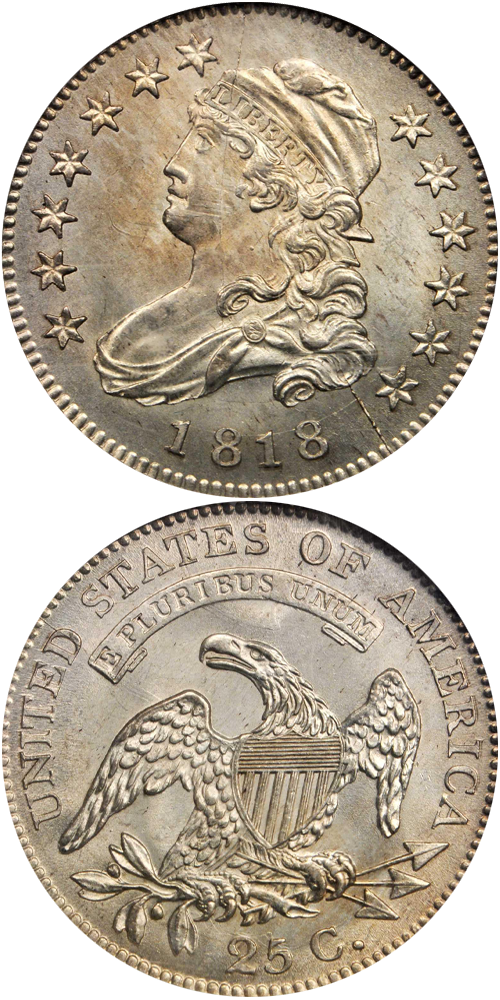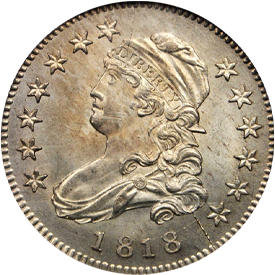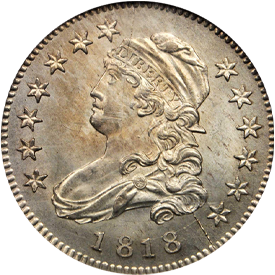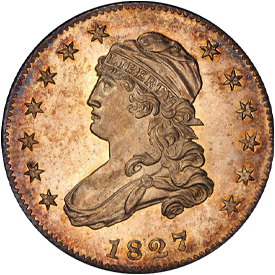Designed by: John Reich
Issue Dates: 1815-1828
Composition: 89.24% silver, 10.76% copper
Diameter: 27 mm
Weight: 6.74 grams (104.01 grains)
Edge: Reeded
Business Strike Mintage: 1,290,584
Proof Mintage: Fewer than 100
Following a suspension of quarter dollar coinage after 1807, the denomination was again produced in 1815, which time the Capped Bust style was introduced. The motifs are similar to that found on other silver denominations of the era. The obverse depicts Miss Liberty facing left, wearing a cloth cap secured with a band inscribed LIBERTY, with tresses flowing to her shoulder. Her plunging neckline is draped in cloth and is secured by a brooch or a clasp at the shoulder. Seven stars are to the left and six are to the right. The date is below. The reverse shows an eagle perched on a branch and holding three arrows, a shield on its breast, and E PLURIBUS UNUM on a scroll above. UNITED STATES OF AMERICA and 25 C. appear around the border.
While several dates within this range are scarce, and the 1823/2 and 1827 are major rarities, the type set collector will have no difficulty acquiring one of the more plentiful issues. Typically encountered specimens are apt to range from Very Good to Very Fine preservation. While they are not as easily located as half dollars of the same years and designs, still there are enough around that acquiring one will be no problem. Extremely Fine specimens are scarce, AU pieces are scarcer yet, and strictly Uncirculated coins are rare. Striking quality varies from issue to issue, and many show weaknesses in certain areas, although with some searching you should be able to buy a well-defined piece.
Further Reading
No quarter dollars were produced from 1808 through 1814 inclusive. In 1815 a new design, the Capped Bust obverse, in combination with a perched eagle reverse, appeared. The motto E PLURIBUS UNUM is inscribed on a band above the eagle's head. This general motif was continued through 1828, after which coinage of the denomination was suspended until 1831. From 1831 through 1838 the design was modified to a slightly smaller diameter, a different inner border, and several other details, including the omission of the E PLURIBUS UNUM motto. Today, quarters are often collected two ways. The first is by the general Capped Bust type from 1815 through 1838. The second is the more specialized way, one coin to illustrate the 1815-1828 style and the other to illustrate the 1831-1838 format. The earlier quarters include a number of interesting varieties. Several overdates exist, including 1818/5, 1823/2 (about which more will be written later), 1824/2, several perplexing 1825 issues, and the "forgotten overdate" 1827/3 (to which subject I will return).
The 1823/2 has always been considered a rarity in American coinage. The noted half dime specialist, Harold P. Newlin, considered this to be one of four landmark United States silver coins, the others being the 1802 half dime, the 1827 quarter, and the 1804 silver dollar. Newlin's words were written in 1883, an era before mintmark collecting became popular. Today, any enumeration of the "rarest of the rare" silver coins would undoubtedly contain such items as the marvelous 1870-S half dime, the unique 1873-CC dime without arrows, the famous 1894-S dime, the classic 1876-CC twenty-cent piece, and numerous others. But, at a time when listings were far less complex than they are now, the 1823/2 quarter dollar stood out as being prominent.
Curiously, nearly all known specimens show signs of extensive wear. In an article in the April 1983 issue of The Numismatist, Carl Herkowitz noted that of the dozen or so examples he was able to trace, “the average grade of existing pieces is about Very Good.” In an 1885 interview, Sylvester S. Crosby discussed the United States Mint's coin collection and noted that several pieces of the regular series were conspicuous by their absence, among them being the 1802 half dime and the 1823 quarter. The issue received little publicity during the cradle days of American numismatics. By the time its rarity was recognized, most examples had been in circulation for decades.
In recent times the 1823/2 has lapsed into relative obscurity. Many American rarities, the 1804 silver dollar being an example, offer a degree of elusiveness plus high condition. The "high condition" aspect is missing for this particular quarter dollar, except for one or two surviving pieces, and its fame has suffered.
The prime rarity among quarter dollars of the Capped Bust type is the 1827/3. Years ago, this issue was described as an overdate. References such as The Early Quarter Dollars of the United States 1796-1838, by A.W. Browning, 1925, lists it as 1827/3, as did various other published sources of times past. But, in more recent decades the overdate feature has been generally overlooked. The undertype 3 shows boldly under the 7. As no perfect-date 1823 quarters were struck (the 1823/2 overdate is the only example known of this year), it is surmised that at least two such "perfect date" 1823-dated dies were made, not used in 1823, but were kept on hand and later overdated 1825/3 and 1827/3.
The 1827 quarter is listed in the Mint records as having been made to the extent of 4,000 business strikes, but as all known examples are either Proofs or impaired Proofs, it is likely that these 4,000 pieces, if made, bore another date. Walter Breen has opined that 12 Proofs may have been minted originally. Neither the number of extant Proofs nor their origin is absolutely certain. When our firm offered the Gar rett Collection example in 1980, we pinpointed the location of 10 different coins. The Garrett piece is believed to have been one of four specimens obtained by collector Joseph J. Mickley, then 28 years old, for face value during a visit to the Mint in the year of issue.
For many years the 1827 original quarter has been considered a landmark in American coinage. Countless comparisons have been made between the 1827 quarter and the 1804 silver dollar (which, despite its greater fame, actually appears to be slightly more plentiful), the 1802 half dime, and other spectacular rarities. Certainly, it is one of the great classics in our coinage history.
Sometime around 1860 the obverse die of the 1827 quarter, having been sold as scrap metal by the Mint, was resurrected for further coinage use in combination with a reverse die not originally used in the 1827 year. These restrikes from rusted dies were made in silver and copper and are great rarities in themselves, although they do not have the cachet of the original pieces.
Certain varieties of 1822 and 1828 quarters have a common reverse displaying an interesting blunder. The engraver thought he was making a die for a half dollar and started cutting "50" rather than "25"! This error was soon discovered, and the proper 25 number was cut over the mistake. The result is known today as the "25 over 50c" variety. After it was used in 1822 it apparently went on the shelf and was not employed again until mated with an 1828 obverse die six years later.
For many years a prime "given'' in numismatic research was that dies were used in coining presses until they were worn out. Thus, according to former tradition, a new obverse and reverse die would be put in the press at the inception of coinage. Then when one of the dies, say the obverse in this example, broke or became too worn for use, it would be replaced, but the reverse die would remain the same. Coinage would continue, then perhaps the reverse die would break, necessitating replacement. If in a study of die varieties, the obverse dies are given numbers and the reverse dies are given letters, then the first coin struck would be variety 1-A. Following replacement of the obverse die, variety 2-A would be made, then 2-B, when the reverse die broke. Sometimes an obverse die would outlast several reverses, or vice versa. Thus, continuing the example, such varieties as 6-D, 7-D, 8-D, and 9-D, would indicate that one reverse die had great longevity and outlived many obverses.
But, varieties such as the 1822 and 1828 quarters sharing the error reverse indicates that dies were not used in such a neat sequence. It was often the case that dies would be removed from the press, put on the shelf, and not used until later, perhaps years later. An interesting exposition of this situation, which to the present writer seems to be much closer to the truth than the traditional view, was made by Robert P. Hilt II in his Die Varieties of Early United States Coins, published in 1980. The volume, which has not received the attention it deserves in the numismatic community, contains some very interesting thoughts, including revised coinage figures for certain issues (the 1794 silver dollar being an example).
Quarters of the 1815-1828 years, with the exception of 1823/2 and 1827, are readily available in worn grades. Even Very Fine to Extremely Fine pieces are seen with a fair degree of frequency. AU examples are elusive, and MS-65 is a grade rarely seen. It is no exaggeration to observe that any quarter within this range is very rare in superb Mint State. Some varieties are sufficiently rare that only a few pieces exist in Uncirculated preservation, the 1822 with error reverse being an example.









